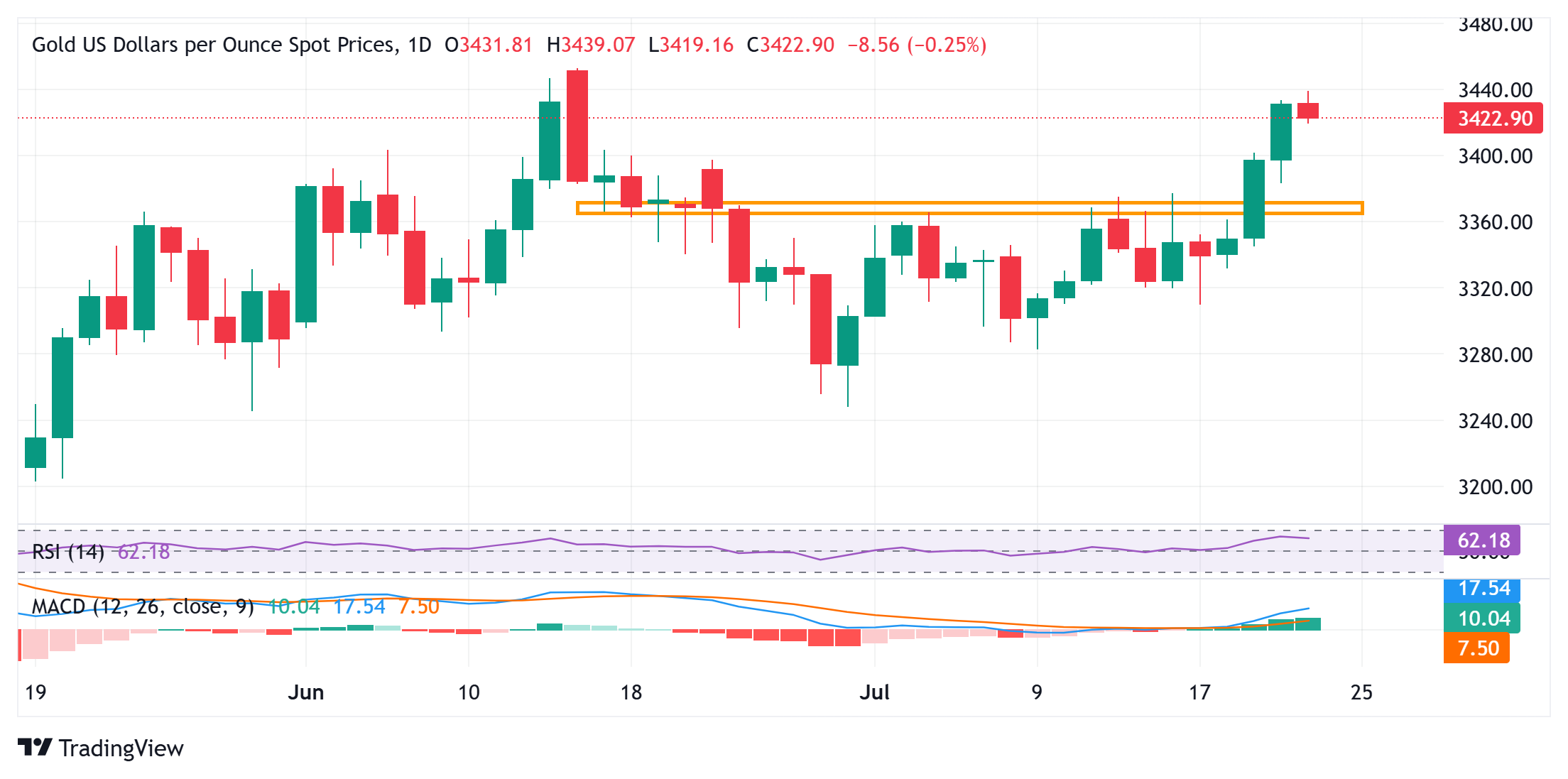Gold price retreats from monthly top as modest USD strength prompts profit-taking
- Gold price drifts lower after rising to over a one-month peak during the Asian session.
- A modest USD bounce and a positive risk tone seem to undermine the precious metal.
- The uncertainty over the Fed’s rate-cut path warrants some caution for the USD bulls.
Gold price (XAU/USD) retreats from its highest level since June 16, around the $3,439 region touched during the Asian session on Wednesday, and for now, seems to have snapped a three-day winning streak. The global risk sentiment gets a fresh boost after US President Donald Trump announced a trade deal with Japan. This, in turn, undermines the safe-haven precious metal and prompts some profit-taking amid a modest US Dollar (USD) recovery.
The USD uptick, however, lacks bullish conviction amid the uncertainty over the likely timing and the pace of interest rate cuts by the Federal Reserve (Fed). This is seen offering some support to the non-yielding Gold price and helping limit deeper losses. Hence, it will be prudent to wait for strong follow-through selling before confirming that the XAU/USD has topped out in the near term and positioning for any meaningful corrective decline.
Daily Digest Market Movers: Gold price is pressured by fading safe-haven demand; modest USD strength
- US President Donald Trump announced in a social media post that his administration had completed a massive trade deal with Japan. Trump added that Japan will pay reciprocal tariffs of 15% and will open its country to trade, including cars and trucks, rice, and certain other agricultural products.
- The positive developments trigger a fresh wave of the global risk-on trade and dent demand for traditional safe-haven assets. Apart from this, a modest US Dollar bounce from a two-week low touched on Tuesday drives some flows away from the Gold price during the Asian session on Wednesday.
- Meanwhile, Trump continues to push for lower interest rates and has publicly called for Federal Reserve Chair Jerome Powell’s resignation. Moreover, US Treasury Secretary Scott Bessent renewed calls for a sweeping internal review of the Fed’s operations, fueling worries about the central bank's independence.
- This, in turn, is holding back the USD bulls from placing aggressive bets. Furthermore, the uncertainty over the eventual state of tariffs globally has been a huge overhang for traders, which could further act as a tailwind for the non-yielding yellow metal and help limit any meaningful corrective decline.
- Traders now look forward to the release of the US Existing Home Sales data for some impetus later during the North American session. The focus, however, will remain glued to the release of the global flash PMIs, which will influence the global risk sentiment and provide a fresh impetus to the XAU/USD pair.
Gold price is likely to attract some dip-buyers near the $3,400 mark amid a constructive technical setup

From a technical perspective, this week's breakout through the $3,368-3,370 horizontal barrier and a subsequent move beyond the $3,400 mark on Tuesday was seen as a key trigger for bullish traders. Moreover, oscillators on the daily chart are holding comfortably in the positive territory and are still away from being in the oversold zone. Hence, any further decline might still be seen as a buying opportunity near the $3,400 round figure. Some follow-through selling, however, might negate the positive outlook and drag the Gold price back towards the $3,370 resistance-turned-support.
On the flip side, the Asian session peak, around the $3,438-3,439 region, now seems to act as an immediate hurdle ahead of the July swing high, around the $3,451-3,452 zone. A sustained strength beyond the latter should pave the way for a move towards retesting the all-time peak, around the $3,500 psychological mark touched in April.
Gold FAQs
Gold has played a key role in human’s history as it has been widely used as a store of value and medium of exchange. Currently, apart from its shine and usage for jewelry, the precious metal is widely seen as a safe-haven asset, meaning that it is considered a good investment during turbulent times. Gold is also widely seen as a hedge against inflation and against depreciating currencies as it doesn’t rely on any specific issuer or government.
Central banks are the biggest Gold holders. In their aim to support their currencies in turbulent times, central banks tend to diversify their reserves and buy Gold to improve the perceived strength of the economy and the currency. High Gold reserves can be a source of trust for a country’s solvency. Central banks added 1,136 tonnes of Gold worth around $70 billion to their reserves in 2022, according to data from the World Gold Council. This is the highest yearly purchase since records began. Central banks from emerging economies such as China, India and Turkey are quickly increasing their Gold reserves.
Gold has an inverse correlation with the US Dollar and US Treasuries, which are both major reserve and safe-haven assets. When the Dollar depreciates, Gold tends to rise, enabling investors and central banks to diversify their assets in turbulent times. Gold is also inversely correlated with risk assets. A rally in the stock market tends to weaken Gold price, while sell-offs in riskier markets tend to favor the precious metal.
The price can move due to a wide range of factors. Geopolitical instability or fears of a deep recession can quickly make Gold price escalate due to its safe-haven status. As a yield-less asset, Gold tends to rise with lower interest rates, while higher cost of money usually weighs down on the yellow metal. Still, most moves depend on how the US Dollar (USD) behaves as the asset is priced in dollars (XAU/USD). A strong Dollar tends to keep the price of Gold controlled, whereas a weaker Dollar is likely to push Gold prices up.
